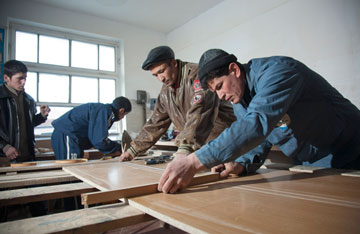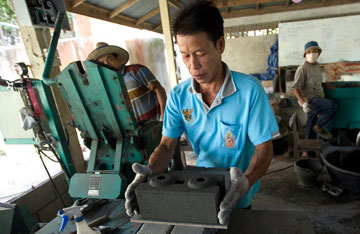Helping more families through housing support services -- Habitat for Humanity Int'l 1
Helping more families through housing support services
By Steve Weir
|
|

Carpentry student Ilmiddin Toshmatov (right) works alongside master carpenter Sheroz Kholmurodov in the Building and Training Center run by Habitat Tajikistan with support from the Canadian International Development Agency. The center is designed to create employment opportunities for disadvantaged groups. More than 200 people each year gain vocational skills and HIV/AIDS awareness through the 18 courses at the center. ©Habitat for Humanity/Steffan Hacker.
|
|
|
|
|
|

A future Habitat homeowner learns to make interlocking blocks in the Muang Len community in Chiang Mai, Thailand. The blocks were used to build two houses in the community and to supplement other blocks purchased for the Jimmy & Rosalynn Carter Work Project in 2009. Homeowners earned sweat equity by making the blocks both for their homes and for others, and they learned valuable skills that can assist with future livelihood development. ©Habitat for Humanity/Mikel Flamm.
|
|
|
|
This issue surveys a range of innovative housing support service programs and delivery systems and explores how they fit into Habitat’s broader shelter strategy.
At Habitat, we define housing support services, or HSS, as:
A demand-driven service or product designed to enable a household to:
a) Reach an adequate[1] housing quality standard in secure tenure, basic services, and shelter durability and space.
b) Make shelter-related improvements in health, safety and livelihood.
HSS is quickly becoming a significant “scaling” strategy, serving more families than new or rehab construction annually.
It allows Habitat for Humanity to leverage our core competency of housing and housing processes by partnering with low-income financial institutions, housing service companies and social entrepreneurs.
The HSS approach is a significant shift from Habitat’s work as a contractor or construction manager toward consultancy and training, responding to homeowner demand. This is an enabling approach rather than a production approach.
As a complement to HSS, Habitat also provides technical assistance consultation to partner organizations so that they can provide housing support services directly to families and communities.
This issue of The Forum explores how the HSS concept is being implemented by Habitat around the world. In her article on HSS in Nepal, Hiew Peng Wong shows how a clear understanding of local housing conditions leads to the choices of HSS as a scalable intervention strategy. Patrick Kelley explains how 11 Habitat countries are involved in a special learning project to test HSS approaches empirically.
Bob Longino explores how construction technical assistance is helping homeowners in Malawi to make better use of small housing improvement loans. Peter Witton reviews the history of the Habitat Resource Center, which emerged in the Asia/Pacific region as a vehicle to provide HSS in the aftermath of the 2004 Indian Ocean tsunami.
Monica Ramirez from Latin America and the Caribbean shows how HSS is closely linked to the community development strategies pursued in that area. And Katerina Bezgachina of Europe and Central Asia shows how HSS is suited to partnership approaches with microfinance institutions that make small housing loans to their clients.
Habitat’s approach to housing support services
Habitat for Humanity International uses housing value chain analysis to identify gaps in the informal incremental housing process. This has led us to develop a growing complement of demand-driven HSS.
Two components of these housing support services are:
1) Construction technical assistance: Direct consultation to a household that does not include direct construction, oversight or construction management.
2) Nonconstruction, including:
- Legal: Tenure, permits and entitlements.
- Design: Life cycle affordability, incremental, sustainable building, disaster resiliency.
- Training: Financial capability, skilled and nonskilled construction, tool rental, material production, certification.
- Access: Information resources/networks, supplier linkages, qualified contractors and product suppliers, government and private subsidy programs and services.
Interventions that are not included in housing support services are:
- Construction, construction management or oversight, repairs or home improvements.
- Financial products.
- Nonshelter-related or shelter-enabling improvements, trainings or consultations.
Recognizing that the shelter inadequacy of the urban poor is often the result of inadequate public policy and urban planning, our approach to HSS is based on providing access to shelter-related information and services while pursuing policy changes that support adequate housing.
Developed economy origins vs. current usage
Housing support services[2] is a term that has been used for several decades by social service agencies in economically developed economies in the global North. These agencies provide referral services to housing programs and subsidies for low-income, vulnerable populations. Typically, they define housing support services as services provided to any person to develop that person’s capacity to live an independent, productive life or to sustain his or her capacity to do so.
These services cover a range of activities, including advice on budgeting and debt management; assistance with benefit claims; help maintaining the security of the dwelling; assistance with disputes with neighbors; and general counseling and advice. These are often provided alongside “supportive housing or service-enhanced housing” for special needs populations.
There is much in the original use of the term housing support services that is consistent globally with economically developing economies — but there are distinct differences. In many urban cities in the global South, the average “urban workforce” household includes teachers, policemen and entry-level government and private-sector salary workers. These are not “special needs” families requiring case management, but fully productive households needing access to information and services to help them better invest in their own incremental shelter improvements.
Strategic positioning
The rise in importance of this approach has led us to redefine how we count and communicate Habitat’s work in the field. We will now track and communicate to our external public 1) construction, 2) housing support services and 3) volunteers as three distinct critical activities. Previous “nonconstruction” activities will be renamed “housing support services” in an effort to reposition and promote nonconstruction HSS interventions as important activities in their own right. We continue to include construction technical services, a growing HSS delivered directly to the family, under the appropriate “construction” category.
Research, development and global peer learning exchanges
In 2010, we launched the first global Strategic Investment Grant, a three-year global learning initiative to refine HSS approaches for Habitat. The SIG will identify best practices and develop sustainable business models by supporting and evaluating the demand-led HSS provided in 11 countries from throughout HFHI’s program regions. We began the grant with a global training in Nicaragua to learn from PRODEL, a development program globally recognized for its housing support services. PRODEL’s research suggests that its services divide into three categories, each with different levels of HSS options to build and promote sustainable businesses. We would like to adopt and further develop this framework in Habitat.
Level 1 – Nonskilled maintenance and repair: This requires basic handout materials on things like how to hire and oversee a contractor as a homeowner, access to HSS information in the community or over the Web, and tips on disaster-resilient construction where appropriate.
Level 2 – Skilled: This requires a mason or carpenter but is not technically or structurally complicated.
Level 3 – Complex: This involves structural work that benefits from trained technical support.
Interestingly, PRODEL in Nicaragua found that Level 1 represented nearly 80 percent of its loans; Level 2 represented 18 percent; and Level 3 represented only 2 percent. If these prove to be globally representative, Habitat should be able to provide local, community-based organizations and microfinance institutions with information that they can distribute to all levels and also offer workshops through Habitat Resource Centers. If only 2 percent of the families require technical support, this suggests a very different business model from the one Habitat has typically used.
Conclusion
Housing support services provides a significant shift from Habitat as a contractor or construction manager toward consultancy and training, responding to homeowner demand. While some argue that the poor will neither appreciate nor pay for these services, the experience of PRODEL in Nicaragua and others suggests this is not the case when these services are aligned with and appropriate for varying levels of construction complexity.
Construction and construction management will continue to be an important part of the Habitat portfolio. However, if we are to work effectively in an increasingly urbanizing world and to have influence at any scale, we will need to master and develop effective, sustainable housing support services.
Finance institutions are focused on providing the best housing financial products. Housing NGOs are focused on providing quality housing for the poor. Housing support services may prove to be the way that we meet in the middle of the continuum, providing equal access to information to 80 percent of the households globally who improve their homes each year.
In the end, this can become a catalytic initiative to realize our vision: A world where everyone has a decent place to live.
Steve Weir is vice president of Global Program Development and Support at Habitat for Humanity International.
Sources:
[1] Habitat for Humanity International defines adequate shelter as one with access to secure tenure, water and sanitation, adequate space, and durable structure.
[2] Today the term is commonly accompanied by the term “Supportive Housing.” together, they are defined on Wikipedia as “a combination of housing and services intended as a cost-effective way to help people live more stable, productive lives. Supportive housing is widely believed to work well for those who face the most complex challenges—individuals and families confronted with homelessness and who also have very low incomes and/or serious, persistent issues that may include substance abuse … mental illness, HIV/AIDS, or other serious challenges to a successful life. Supportive Housing can be coupled with such social services as job training, life skills training, alcohol and drug abuse programs and case management to populations in need of assistance, including the developmentally disabled … and elderly people who are medically frail. Supportive housing is intended to be a pragmatic solution that helps people recover and succeed while reducing the overall cost of care.”